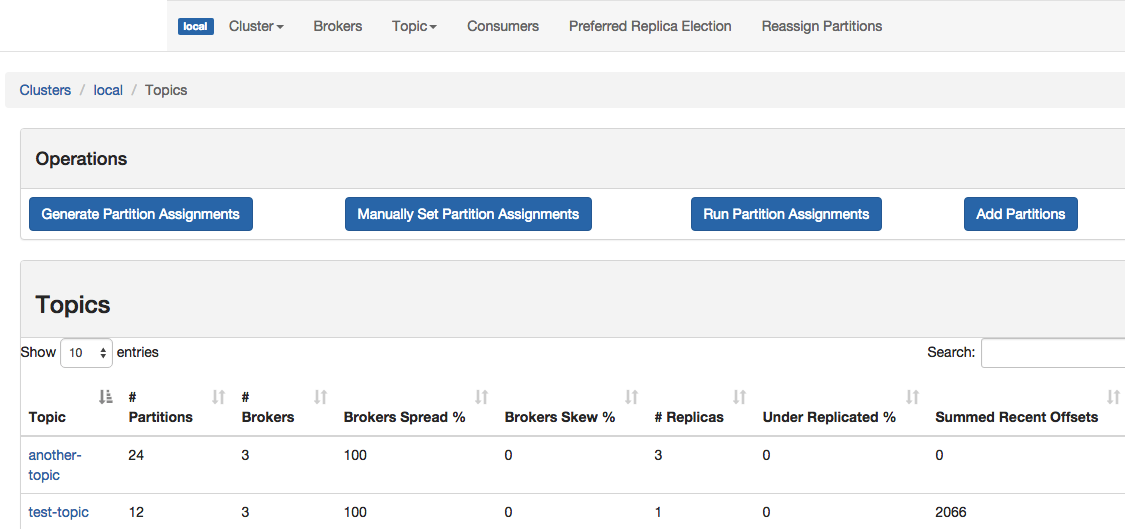 |
| https://kafka.apache.org/powered-by |
Introduction
Apache Kafka is an open-source, distributed message broker based on Scala and Java. It's used as a publish-subscribe messaging system; when a producer publishes a message, it's broadcast, and subscribers can get notified and process the information. It can handle large volumes of real-time data and event streaming pipelines with higher throughput than popular message brokers like ActiveMQ and RabbitMQ. In addition, it's highly scalable and fault-tolerant.
Apache Kafka uses Apache Zookeeper to keep track of its cluster node's status, topics, partitions, and so on. Apache ZooKeeper is an open-source project built for centralized services. It provides configuration information, naming, synchronization and group services for large clusters in a distributed systems.
This article explains how to install Apache Kafka on Ubuntu 20.04 server.
Prerequisites
- Ubuntu 20.04 Server.
- Create a non-root user with sudo access.
1. Install Java
Update system package list.
$ sudo apt update
Install Java 11 AWS Corretto .
$ wget -O- https://apt.corretto.aws/corretto.key | sudo apt-key add -
$ sudo add-apt-repository 'deb https://apt.corretto.aws stable main'$ sudo apt-get update; sudo apt-get install -y java-11-amazon-corretto-jdkVerify the installation.
$ java --version
2. Install Apache Kafka
Download Apache Kafka source files. To find the latest version of this software, visit the official download website.
$ wget https://dlcdn.apache.org/kafka/3.1.0/kafka_2.12-3.1.0.tgz
Create an installation directory /usr/local/kafka-server.
$ sudo mkdir /usr/local/kafka-server
Extract the downloaded files.
$ sudo tar -xzf kafka_2.12-3.1.0.tgzMove the extracted files to the installation directory.
$ sudo mv kafka_2.12-3.1.0/* /usr/local/kafka-serverFor Apache Kafka and Apache Zookeeper to run as daemons, create systemd files for both of them.
Creating systemd file for Apache Zookeeper.
$ sudo nano /etc/systemd/system/zookeeper.service
Add the following lines of code to the file, save and close the file.
[Unit]
Description=Apache Zookeeper Server
Requires=network.target remote-fs.target
After=network.target remote-fs.target
[Service]
Type=simple
ExecStart=/usr/local/kafka-server/bin/zookeeper-server-start.sh /usr/local/kafka-server/config/zookeeper.properties
ExecStop=/usr/local/kafka-server/bin/zookeeper-server-stop.sh
Restart=on-abnormal
[Install]
WantedBy=multi-user.target
Creating systemd file for Apache Kafka.
$ sudo nano /etc/systemd/system/kafka.service
Add the following lines of code to the file, save and close the file.
[Unit]
Description=Apache Kafka Server
Documentation=http://kafka.apache.org/documentation.html
Requires=zookeeper.service
After=zookeeper.service
[Service]
Type=simple
Environment="JAVA_HOME=/usr/lib/jvm/java-11-openjdk-amd64"
ExecStart=/usr/local/kafka-server/bin/kafka-server-start.sh /usr/local/kafka-server/config/server.properties
ExecStop=/usr/local/kafka-server/bin/kafka-server-stop.sh
Restart=on-abnormal
[Install]
WantedBy=multi-user.target
Reload the systemd daemons to apply the changes.
$ sudo systemctl daemon-reload
Start and enable the Apache Zookeeper service for startup on system boot.
$ sudo systemctl enable --now zookeeper.service
Start and enable the Apache Kafka service for startup on system boot.
$ sudo systemctl enable --now kafka.service
Verify the status of both Apache Zookeeper and Apache Kafka services.
$ sudo systemctl status kafka zookeeper
3. Install Cluster Manager for Apache Kafka (CMAK).
CMAK is a graphical management tool for Apache Kafka clusters. It provides the user with various tools to avoid using the CLI interface.
Clone the CMAK repository from GitHub.
$ git clone https://github.com/yahoo/CMAK.git
Edit the CMAK configuration file.
$ sudo nano CMAK/conf/application.conf
Change the value of cmak.zkhosts as follows.
cmak.zkhosts="localhost:2181"
Change to the CMAK directory.
$ cd CMAK
Create a zip file used for deploying the application.
$ ./sbt clean dist
Change into CMAK/target/universal directory.
$ cd target/universal
Install unzip package.
$ sudo apt install unzip -y
Extract the created zip file.
$ sudo unzip cmak-3.0.0.5.zip
Change to the extracted directory.
$ cd cmak-3.0.0.5
Execute the CMAK binary to start the service.
$ sudo bin/cmak
4. Access CMAK Web Interface
Open your web browser and access the CMAK web interface using the URL http://ServerIP:9000. For example:
http://192.0.2.10:9000
Conclusion
You have installed Apache Kafka and Apache Zookeeper on your server. You can now access the CMAK dashboard and add a Kafka cluster.
